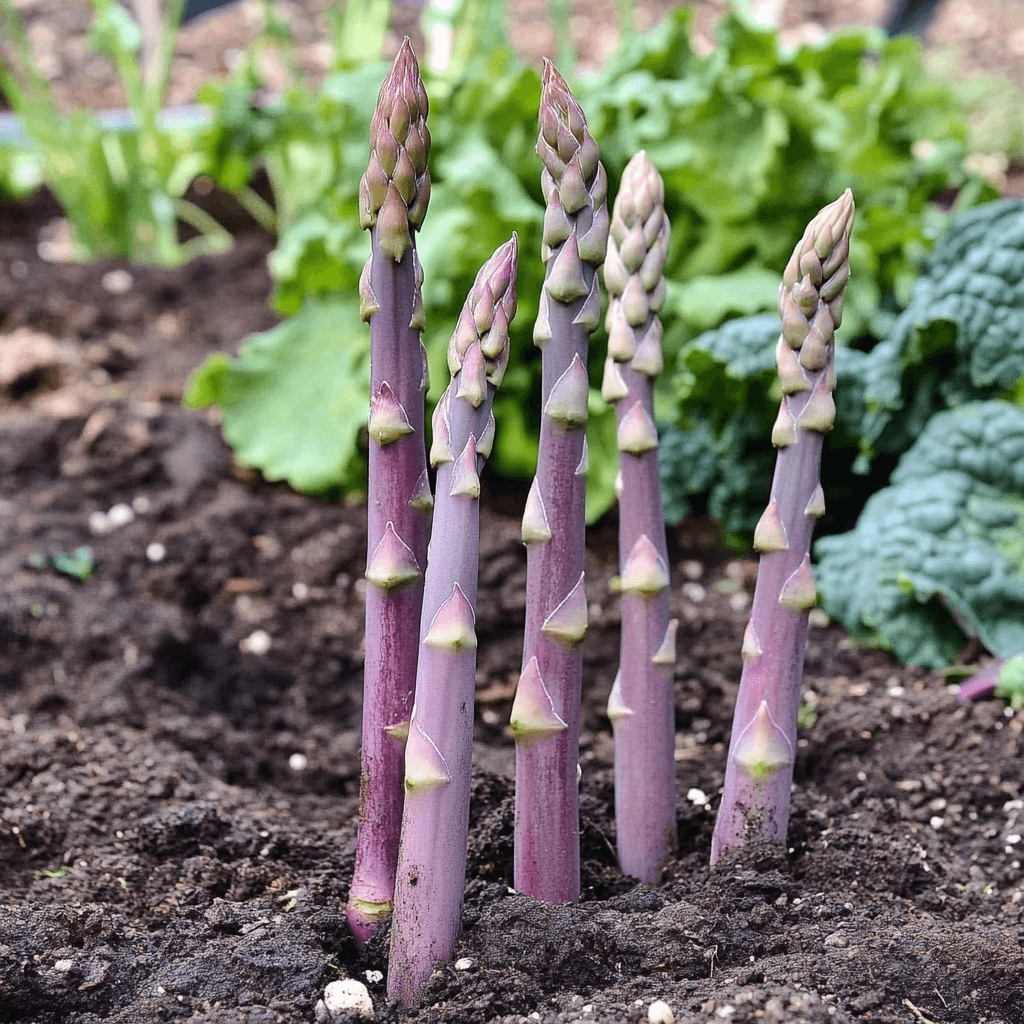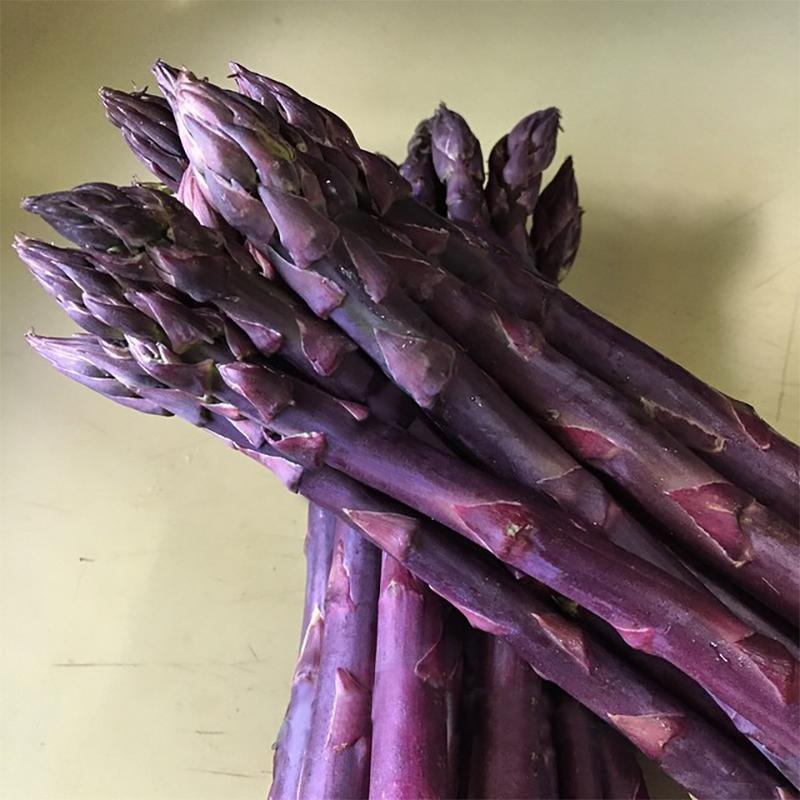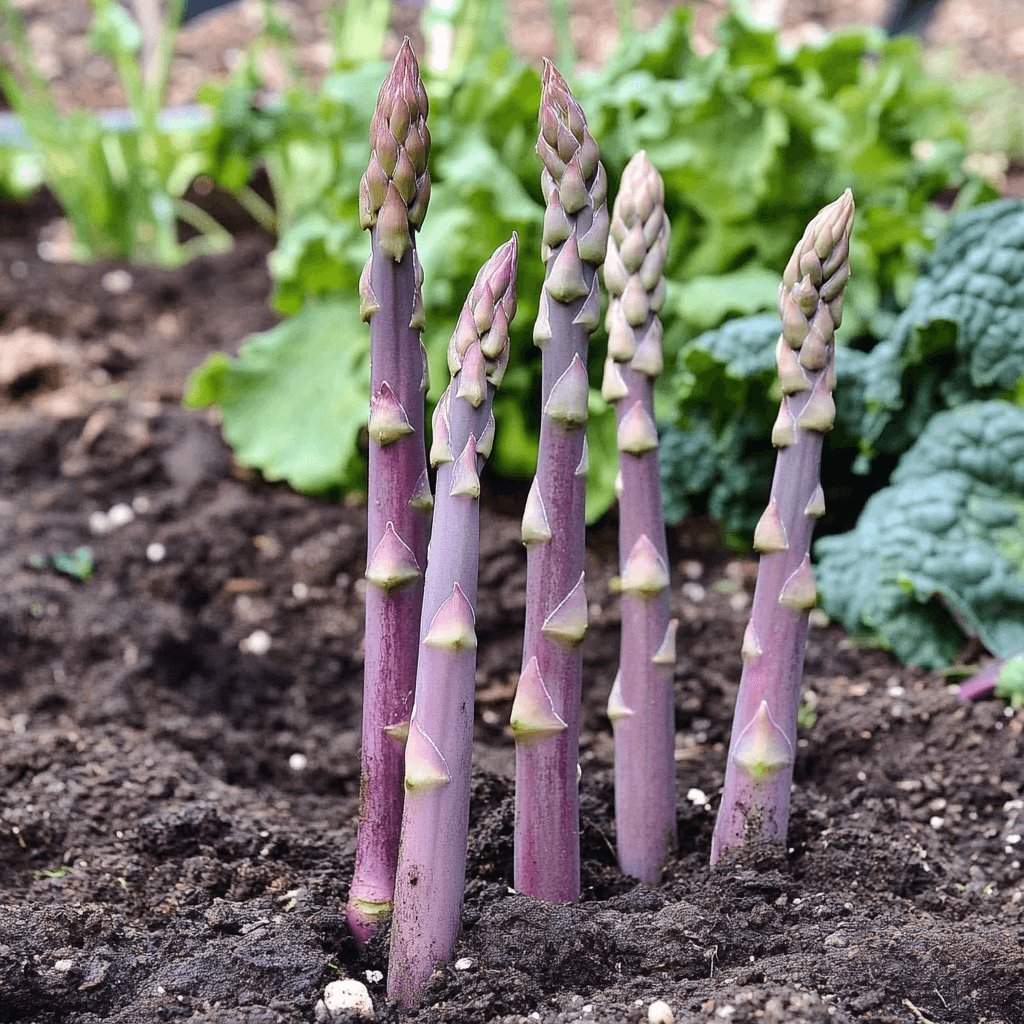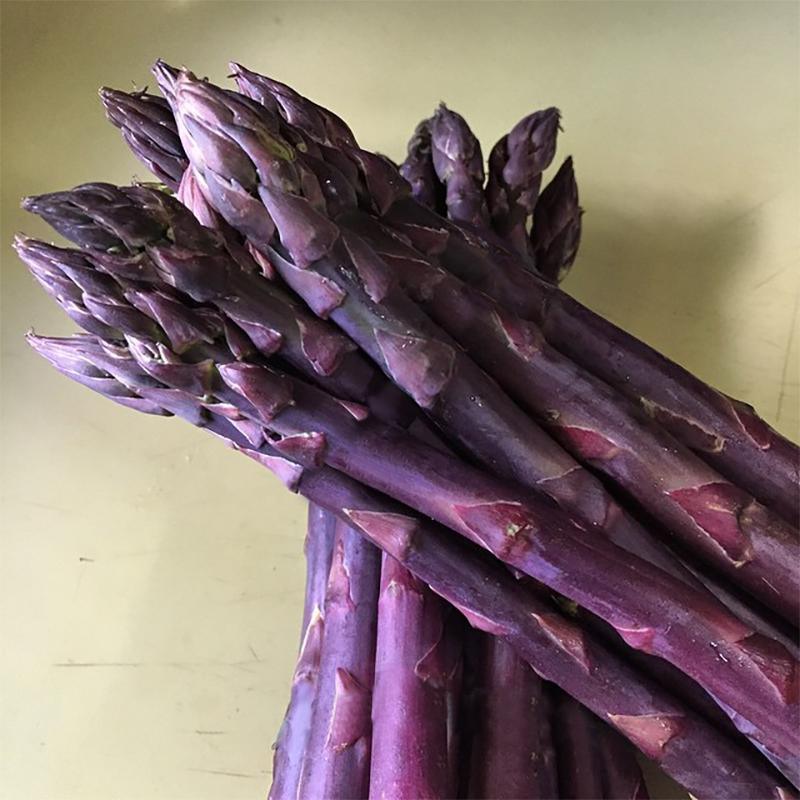Item Number: FV210
Asparagus Purple Passion
Vibrant spears with a sweet twist.
Mix-and-match for free shipping when purchasing 6 or more perennial berries, vines, or crowns! Purple Passion asparagus is a unique and striking variety, producing thick, tender spears with a vibrant purple hue. Known for its sweet, nutty flavor, this asparagus is perfect for fresh eating, steaming, or adding a gourmet touch to salads and side dishes. The spears retain their color when lightly cooked, making them an eye-catching addition to any meal. Thriving in full sun and well-draining soil, Purple Passion is disease-resistant and performs well in a variety of climates. With its exceptional flavor, ornamental appeal, and reliable yields, Purple Passion asparagus is a standout choice for gardeners.
- 10 root crowns per bundle
- USDA zones 3-10
- Deep-burgundy colored spears.
- Has a 20% higher sugar content. Because of this extra sweetness, this vegetable is often eaten raw. Some upscale restaurants garnish salads with purple asparagus. When cooked, the sweetness gives this asparagus a mild, nutty flavor.
- The spears are generally larger and much more tender than its green counterpart. The vascular bundles have less lignin per spear which make the spears less stringy. This allows the cook to use the entire spear with little waste.
For more information, please enjoy our Growing Guide for planting and growing asparagus.
Note: Do not be alarmed if there is small amounts of bluish-white mold on your rootstock, this is absolutely normal. It occurs from the cold storage process used to keep the plants dormant. This mold can be wiped off and will not affect the health of the plant. However, if the plants are rotten and/or mushy, please give us a call.
Browse our collection of asparagus.
Growing Purple Asparagus: A Guide to Cultivating this Unique Variety
Purple asparagus is a captivating and exotic addition to any garden or culinary adventure. Its striking purple coloring sets it apart from the more common green and white asparagus varieties, making it not only a visual delight but also a delectable treat for the taste buds. In this comprehensive guide, we will explore how to grow and care for purple asparagus, its unique characteristics, and even provide you with a delicious purple asparagus recipe to savor its exceptional flavor.
Purple asparagus (Asparagus officinalis var. purpurea) is a unique and visually stunning vegetable known for its distinctive deep purple hue. Unlike the more commonly found green and white asparagus varieties, the purple asparagus derives its striking color from the presence of anthocyanins, natural pigments that also impart antioxidant properties.
Planting Purple Asparagus
Growing purple asparagus requires some initial effort, but the rewards are well worth it. Here's a step-by-step guide to help you get started:
- Select the Right Location: Purple asparagus thrives in well-drained soil with plenty of sunlight. Choose a spot in your garden that receives at least 6-8 hours of direct sunlight daily.
- Prepare the Soil: Prepare the soil by adding organic matter like compost or well-rotted manure to improve its fertility and drainage. Aim for a pH level between 6.5 and 7.0, slightly acidic to neutral.
- Choose Asparagus Crowns: Purchase high-quality purple asparagus crowns from a reputable nursery or garden center. It's essential to start with healthy, disease-free crowns for a successful harvest.
- Plant the Crowns: Dig trenches approximately 8-10 inches deep and 12-18 inches apart. Place the crowns in the trenches, spacing them 12-18 inches apart, and cover them with 2-3 inches of soil.
- Watering and Mulching: Keep the soil consistently moist, especially during the growing season. Mulch the asparagus bed with straw or compost to retain moisture and suppress weeds.
- Fertilize Sparingly: Asparagus plants do not require excessive fertilization. Apply a balanced fertilizer in early spring when the shoots emerge.
- Support the Growth: Purple asparagus plants can grow tall and may need support to prevent bending or breaking. Use stakes or a trellis system to help the plants stand upright.
Caring for Purple Asparagus
Caring for purple asparagus is relatively straightforward but requires attention to detail:
- Weed Control: Regularly remove weeds from the asparagus bed to reduce competition for nutrients and water.
- Harvesting: Purple asparagus is typically ready for harvesting in the second or third year after planting. Harvest when the spears reach 6-8 inches in length by snapping them at ground level. Avoid over-harvesting to allow the plant to continue growing.
- Pruning: In late winter or early spring, prune the asparagus ferns down to ground level to prevent diseases and encourage healthy new growth.
- Pest and Disease Management: Keep an eye out for common asparagus pests such as asparagus beetles and aphids. Employ organic pest control methods or consult with a local gardening expert for advice.
Unique Characteristics of Purple Asparagus
Purple asparagus is not only known for its striking purple coloring but also for its distinctive flavor and texture. Here's what sets it apart:
- Color: The most obvious unique feature of purple asparagus is its vibrant purple hue, which adds a visually appealing touch to dishes.
- Flavor: Purple asparagus is typically milder and sweeter than green asparagus. It has a delicate, slightly nutty flavor that pairs well with various culinary preparations.
- Texture: The texture of purple asparagus is tender and succulent, making it a delightful addition to salads, stir-fries, and other dishes.
- Nutritional Benefits: Purple asparagus shares many of the same nutritional benefits as its green and white counterparts, such as being a good source of vitamins, minerals, and dietary fiber.
Purple Asparagus with Olive Oil and Lemon Zest
Ingredients:
- 1 bunch of fresh purple asparagus
- 2 tablespoons of olive oil
- Zest of one lemon
- Salt and pepper to taste
Instructions:
- Preheat your oven to 400°F (200°C).
- Wash the purple asparagus spears and trim the tough ends.
- Place the asparagus spears on a baking sheet, drizzle with olive oil, and sprinkle with lemon zest, salt, and pepper.
- Toss the asparagus to coat evenly with the seasonings.
- Roast the asparagus in the preheated oven for 10-15 minutes or until they are tender but still slightly crisp.
- Serve your purple asparagus with a drizzle of extra olive oil and additional lemon zest for a burst of fresh flavor.
Exploring Purple Asparagus at Farmers Markets
If you don't have the space or time to grow purple asparagus in your garden, you can still enjoy its unique flavor and beauty by visiting local farmers markets. Many farmers and vendors offer purple asparagus when it's in season. It's a great way to support local agriculture and discover new culinary delights.
Growing purple asparagus is a rewarding experience that allows you to enjoy the striking purple coloring, unique flavor, and health benefits of this remarkable vegetable. With proper care and attention, you can cultivate a bountiful harvest and savor its delicate taste in various culinary creations. Whether you grow it in your garden or explore it at farmers markets, purple asparagus is a delightful addition to any kitchen. So, why not embark on the journey of cultivating this exotic and vibrant vegetable?
Check Your Zone Compatibility:
Compatible with your zone.
Growing Zone for

Our Guarantee To You
Since 1976, we've served our customers at every stage of growing. Please contact us at any time. We are happy to support and assist you.
Shipping Information
Shipping Information
Cannot ship to the following states: GU, HI, PR, VI
Shipping Weight: 6.0 lb
Dimensions: 15.0"L x 12.0"W x 4.0"H
Features
Features
- Long-Lived
- Plant Spreads
Characteristics
Characteristics
Planting & Care
Planting & Care
Useful Information
Useful Information
Guarantee
Guarantee
Limited Dormant Tree & Plant Guarantee
* Claim deadline is June 15th
We guarantee that your dormant tree or plant will arrive in good, viable condition. If your tree arrives in substandard condition, notify us within 3 days of delivery. Please email pictures of the box, inside packaging, the tree and its roots to helpdesk@groworganic.com. We will investigate your claim and process a request to exchange or refund the damaged product.
If your dormant tree or plant has not grown new leaves by June 15th, you may be eligible for our Limited Dormant Tree & Plant Guarantee. This guarantee provides for a store credit for the purchase price of the tree, excluding shipping. Please see the Instructions below.
Important Dates:
- April 1st Dormant trees/plants must be planted in the ground
- May 15th Perform scratch test, if no new leaves have grown
- June 15th Deadline to apply for a dormant tree/plant credit
All required documentation must be received by June 15th for your claim to be considered. Claims or documentation received after June 15th will be denied, without exception. Instructions listed below
Terms and Conditions
We cannot guarantee that your tree or plant will remain alive and healthy after it is received, or bear fruit as there are too many variables in your environment that are beyond our control (i.e. soil preparation, weed and pest control, proper irrigation, chill hours, compatible hardiness for your growing zone, proper choice of pollinator, extreme weather, rodent damage, disease, etc.).
We cannot guarantee that we will be able to provide a replacement tree/plant of the same species either that same growing season or in future years. Customers are responsible for all shipping fees associated with replacement trees and plants.
If we determine that the tree you purchased directly from us is not viable, we will issue you a store credit (not a refund) for the purchase price of the affected dormant tree or plant. Shipping is not included in the dormant tree/plant guarantee. Store credits can be used to purchase any product we sell and are valid for use only until July 1st of the following year.
Historically, 98% of our dormant trees and plants grow and thrive when they have been cared for and planted using our growing guides. Dormant trees and plants must be planted in the ground by April 1st in order to be eligible for credit. If the ground in your area is still frozen solid, you may temporarily plant your tree or plant in a pot.
Potted, non-dormant trees or plants are excluded from this guarantee as they are not dormant at the time of shipment. Evergreen trees such as citrus, avocado and olive trees are not available for credit under the Dormant Tree and Plant Guarantee.
Instructions
We guarantee that your dormant fruit tree or plant will leaf out, if you care for it according to our growing guides. In the unlikely event that your dormant tree or plant does not have leaves by May 15th, follow these simple steps to apply for a store credit:
Before you call or email, please perform a “scratch test” to determine if the tree or plant is still alive. This video shows how to check for live tissue under the bark. Scratch tests need to be done a few inches above and below the graft.
Green Cambium Layer / Living Trees
If the cambium layer under the bark is green, give your tree a little more time. It is still alive, but hasn’t come out of dormancy yet. Check to make sure that it is getting the right amount of deep root water, enough sunlight and that the weather is warm enough for that type of tree/plant to come out of dormancy. Every tree has its own personality and will come out of dormancy at different times. Be sure to submit the required documentation listed below by June 15th, if it doesn’t grow leaves.
Brown Cambium Layer / Dead Trees
If the scratch test shows a brown cambium layer or if your dormant tree/plant doesn’t have leaves by June 1st, please email us at helpdesk@groworganic.com. All required documentation listed below must be received by June 15th for your claim to be considered. To be considered for the guarantee claim, all required documentation must be received by June 15th. Incomplete submissions will be denied.
Required Documentation
- Order number
- Name of dormant tree/plant and the quantity affected
- Photos of each tree or plant showing:
- The roots (tree or plant must be pulled out of the ground)
- The scratch test areas
- The entire tree/plant
We reserve the right to not issue credit for items that have already been replaced. We also reserve the right to require photographic evidence that the tree/plant was not killed by root rot, rodent or mechanical damage.
Share


I am so happy I purchased these purple asparagus. I planted them 18 inches apart and they are already sprouting. This was one of my very best purchases with you! And customer service is awesome with fast responses. Thank you again.
First timer with asparagus so I am thrilled to report it’s growing really well in less than a month after planting.
This is my first attempt growing asparagus. I planted the crowns the day they arrived after reading a few articles about the right way to do this. Everything is growing beautifully!
I followed all directions for planting however, only one or less plant every broke round out of my pack. None of them grew into Tree so I’m assuming they’re toast
The roots I received are huge! Way bigger than anything I have seen in my local stores. Just planted them out, so I don't know how they're doing yet, but I have high expectations!



